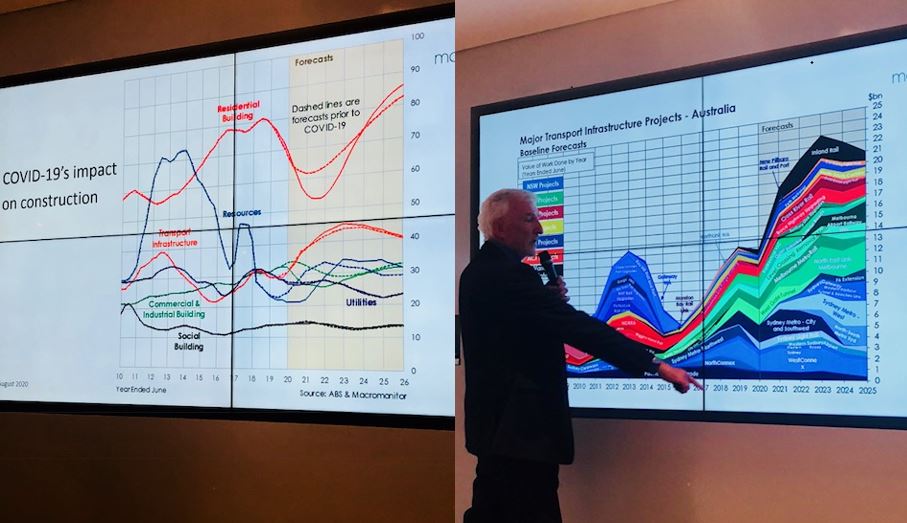PANDEMIC RECOVERY – CONSTRUCTION TRENDS AND FORECAST

Renowned Finance and Economics commentator Michael Pascoe provided an insightful presentation to industry leaders and Executives at last week’s Coraggio Board meeting. Michael’s opening statement led to a robust, insightful and in depth discussion around what we have experienced historically, the trends and recovery, during depression, recession, GFC and mining downturn right through to our current Covid-19 crisis.
Michael’s perspective on Australia’s recovery plan, survival tips and key priorities including what else is needed to create jobs growth and help business rebound was summed up in a thought provoking statement, “To help us get to the other side, though, we need a bridge” Governor Lowe, March 2019
The Morrison Government has provided Australian businesses with a safety net; a financial support package, to assist with the recovery during Covid-19 driven downturn and its many complex challenges. But more needs to be done to build the bridge to recovery and achieve jobs growth.
To help build the bridge to recovery, Michael shared his thoughts on the Job “Bridge” wish list:
- Immediate Social and Public Housing Investment
- Local Government Infrastructure
- Public Building Maintenance Programs
- Electricity Grid for Renewables
- Environmental Monitoring – Crown of Thorns star fish removal
- University Research Funding
- Boost Arts Grants
Here’s more reading from Michael Pascoe ……..
Housing construction starts are set to plunge by 22 per cent this financial year, with the federal government’s HomeBuilder scheme doing little to ease a savage three-year slide.
Construction industry research and forecasting company Macromonitor expects dwelling starts to fall below 129,000 this financial year, down from 165,000 last financial year and 44 per cent below the 2018 peak of 230,000.
“This is due to the big drop in overseas migration inflows, reduced interstate movements, increased dwelling supply as holiday rental stock is switched to full-time rental, a big increase in unemployment, lower incomes and confidence,” Macromonitor director Nigel Hatcher said in a media release with the company’s report on the impact of COVID-19 on the construction industry.
As the accompanying graph shows, pre-COVID, Macromonitor forecast residential building spending to bottom this financial year.
The pandemic is pushing the bottom of the cycle out into the next financial year.
Macromonitor says the value of residential building work done fell from $78.9 billion in 2018-19 to $68.9 billion last financial year.
It is expected to drop to $54.9 billion this year and remain down at $54 billion next financial year.
The residential spend won’t be back to pre-COVID expectations until 2024 – and then will only be where it was in 2016.
Mr Hatcher said the $25,000 HomeBuilder grants “will have a small positive impact”.
In June, Macromonitor was expecting 115,000 starts this year with spending to fall below $50 billion. The trough now is not expected to be as deep, but to last longer.
Despite the HomeBuilder grants being available for some renovations, Macromonitor expects home improvement spending this year to fall by 9 per cent to $8.3 billion.
The report demonstrates the economy was soft before the pandemic hit. Macromonitor found the impact of COVID-19 only trimmed total construction spending by 1.5 per cent in 2019-20, but spending fell by 6 per cent from $212.1 billion to $199.3 billion.
It is forecast to drop another $13.1 billion this year to $186.3 billion.
Pre-COVID, the government and Reserve Bank had been relying on a solid lift in resources construction this year to cushion the economy’s slide, but Macromonitor forecasts spending in the sector will now only be up $1 billion to $22 billion.
After a lift last financial year to $46.6 billion, commercial and industrial building is expected to fall to $40.7 billion this year and $39.9 billion in 2021-22.
“Commercial and industrial building starts are expected to begin dropping sharply in the September quarter, as a result of the reduced need for a range of building types, such as hotels, restaurants, office buildings, stadiums and other venues, while the sharp economic contraction will hit demand for other types of space, such as warehouses, retail and factories,” Mr Hatcher said.
Not all sectors of construction are falling, though. Transport is tipped to rise from $30.5 billion last year to $37.7 million this financial year and $43.2 billion in 2021-22.
Utilities and social building – mainly in health and education – are expected to hold relatively steady.
Of course, what is forecast does not necessarily have to happen.
Like just about every other observer of the industry, Mr Hatcher hopes for more direct government action.
“Further government stimulus measures could provide a substantial offset to some of the expected decline,” he said.
“The $25,000 HomeBuilder grant will have a small positive impact, but larger direct stimulus of the building industry, perhaps through investment in social and affordable housing or other types of public buildings, could still potentially happen in the next round of Budgets in October and November.”
The New Daily: Michael Pascoe: “HomeBuilder not enough to ease three-year construction slide”





